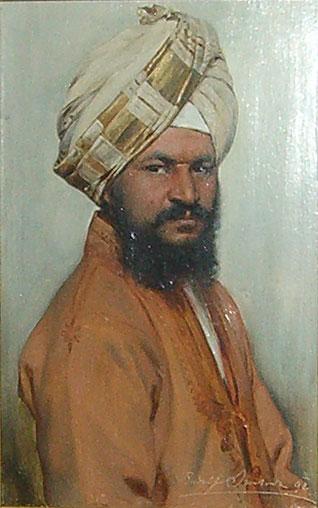
Below: photo of Bhai Ram Singh working in the Durbar Hall, Osborne House, on the Isle of Wight, England.

Architecture
One of The Great Architects of The World:
Bhai Ram Singh
B.N. GOSWAMY
One knows that memories grow faint with time, and giving honour where it is due is not, in general, what we are good at.
But the fact that few even know that there lived a man called Bhai Ram Singh, who built some of the most imposing buildings on the subcontinent -- and in the United Kingdom as well -- close to a hundred years ago, hurts.
It is more than likely that even if you were to ask an alumnus of the Khalsa College at Amritsar (Punjab, India), or one passing out of the famed Aitchison College in Lahore (Pakistan), as to who was the architect of the building they have studied in, one would draw a blank.
And the Punjab University Library at Lahore?
The Mayo School of Arts?
The Lahore Museum?
The interior of the Durbar Hall at Osborne House in England?
The pulpit for the Vice-Regal Lodge, now the Indian Institute of Advanced Study, at Shimla?
In the written histories or notices of these organisations, Bhai Ram Singh will find a mention. But, in general, hardly anyone knows. The man is almost completely forgotten.
And yet, he deserves, richly, to be remembered with respect. His gifts apart, consider the sheer grit with which he must have carved a place for himself, fighting against odds, rubbing against the grain of the social structure of his times in which the 'white' man ruled and all of us were down, way down, below.
To recall, mostly with the help of the splendidly researched book on Bhai Ram Singh by Pervaiz and Sajida Vandal of the National College of Art, Lahore: Ram Singh was born in a simple Sikh family in Rasulpur village, near Batala, in the present district of Gurdaspur in Punjab. The year was 1858, just after India had been proclaimed as a part of the British Empire.
By the time he was 16, he had learnt nearly everything about the family’s trade: carpentry. He moved to Lahore in 1874 where a School of Carpentry had been established to train Punjabi artisans using western methods and serving British needs. In 1875, the recently founded institution was absorbed in the Mayo School of Industrial Art, which was to be headed by a visionary, John Lockwood Kipling, known to most as the father of Rudyard Kipling.
Ever since the British took over, there had been a debate about the future architecture of India: historians like John Fergusson and administrators like Thomas Metcalfe were among those who were participants in it.
There was a marked tilt in favour of projecting the imperial image through architecture that had the feel of the ‘mother country’.
“I wish India to be ruled from a palace”, pronounced a dignitary, grandly, “not from a country house; with the ideas of a Prince, not those of a retail-dealer in muslins and indigo”.
But Lockwood Kipling held, like a few others, different views. It is in “the highest degree desirable”, he felt that attention should be paid “to the systematic study of Oriental Architecture, the source and fountainhead" of all of the subcontinent's Arts.
The Mayo School was certainly conceived as a School of Industrial Art, with an emphasis on design, but, as its principal, Kipling, believed that “it is to the domestic architecture of the country that we must refer if we wish to make a just idea of the present state and future prospects of Indian design as a living force.”
The story is long and involved, but one needs to return to Bhai Ram Singh. He had enrolled in the school of carpentry but with the founding of the Mayo School, he immersed himself in the courses that were gradually being introduced in its curriculum.
Very early on, he caught the eye of Kipling, who recognised his exceptional talent and was to become his mentor and patron in the years that were to follow. From making pieces of elegant furniture and turning out remarkably fine and detailed drawings of designs, Ram Singh was to graduate on to much larger projects as time wore on.
Along with some other students, Kipling took him to Calcutta where a major exhibition was to be held with their work featuring in it. Different architectural projects followed with Ram Singh taking on the role not only of architect but also that of structural engineer, a combination that British architects were more or less unfamiliar with.
In the process, he “never sought to abandon his traditions nor did he turn away from contemporary thoughts on architectural practice”.
The decade between 1883 and 1894 saw a great flowering of the talents of Kipling’s diligent and imaginative protégé. In 1883, Ram Singh joined the services of the Mayo School as Assistant Drawing and Carpentry Master.
He was 25 years old then.
One of the commissions entrusted to Ram Singh and his associates was the designing of the interior of the Billiard Room for the Duke of Connaught at Bagshot Park in Surrey, England.
What he turned out was stunning: two hundred and forty-one carved deodar wood wall panels each with a different pattern. This assignment led to another: designing a large room for the summer retreat of the Queen, Victoria, in England.
In 1891, Ram Singh left for England, for working on the ‘Durbar Hall’. He had gone on a month’s leave from the school but was to stay there for more than two years. When he had finished, laurels poured in, the English press pronouncing him to be a ‘formidable rival for English artists’.
Upon his return to Lahore, commission upon commission followed, some from the Public Works Department, others from Princely states. The buildings named earlier in this piece were only a few among those that Bhai Ram Singh was responsible for or involved in the making of.
His position was rising fast, both in the hierarchy of the School and in the eyes of the public at large. He became Vice Principal of the School that he had been trained in, and in 1910, he was appointed Principal although not before he had to put up a fight against prejudice for “those with a deep complexion.”
He occupied this position for three years before retiring. Three years later, he was gone from this world.
There is a fading sepia photograph of Bhai Ram Singh in his last years that shows him wearing five medals: Sardar Sahib, Sardar Bahadur, MVO, Kaiser-e-Hind, Delhi Durbar Medal.
The expression is gentle and in the eyes almost a hint of tenderness. But he must have been a demanding man, continuingly posing challenges -- as the Vandals say towards the end of their fine study of this remarkable man -- to the brick-makers of Lahore to develop new shapes.
For, with these, he was to “tease out of brickwork the carved texture of wood.” His walls “change with the sun, now shining with strong light and later brooding in the setting sun; they convey messages....”
[Courtesy: Tribune. Edited for sikhchic.com]
November 22, 2012


